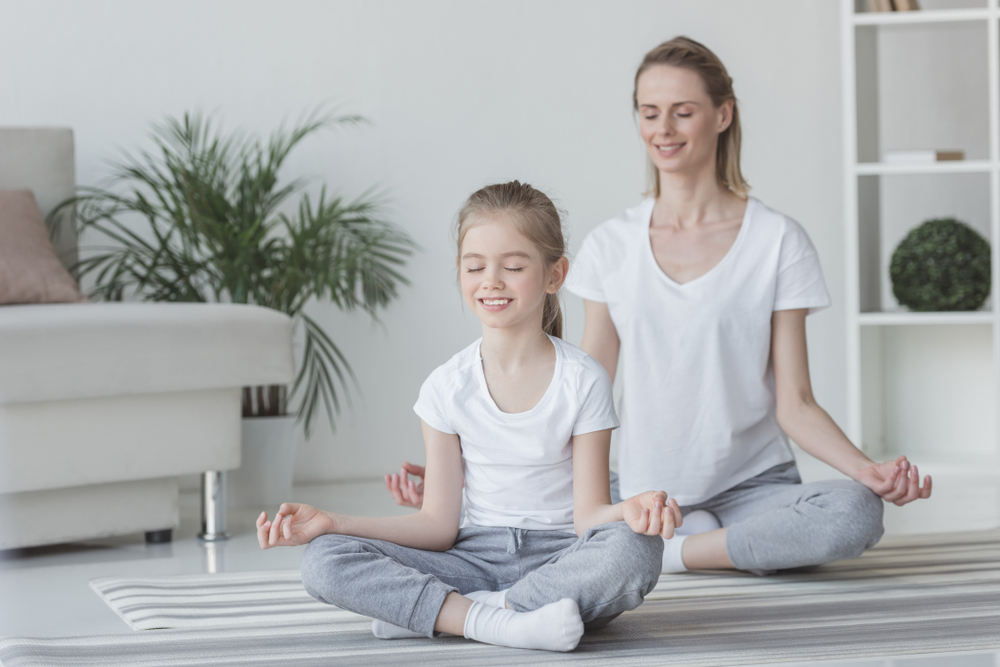As parents, we all live in a hectic and uncertain world. Chaos both inside and outside our homes surround us every day.
We are getting busier and busier but are constantly looking for ways to break up the overload and give our minds a chance to relax.
Activities such as meditation coming to the forefront of self-care and for good reason – the practice has proven to reduce stress and improve health.
Therefore, here are six steps to finding peace in your life based on the principles of meditation that you can easily incorporate into your life:
Step 1: Find a Cool and Quiet Place
The first step to finding peace is to find somewhere that will allow you to feel comfortable and safe where you can meditate undisturbed. You can find a quiet spot outside or curl up in your favorite chair.
Just make sure the space is free from distractions. This can be a challenge for parents during the day, so maybe the evenings are the best times to find quietude.
Starting out with meditation may seem difficult in the beginning but, with a little practice, you will find yourself getting better at it. The key is to eliminate as many distractions as you can in the early stages.
You also need to feel safe, which means meditating in the middle of the woods may not be a great idea. When you feel insecure, it can be difficult to release your anxieties and thoughts.
Make sure you are comfortable. The more comfortable you are, the longer you can meditate. Most meditation periods last around 20 minutes since it can take a good 10 minutes to get to an optimal point of relaxation.
Sit on a comfortable surface before you start meditating, preferably upright. If sitting on the floor is difficult, try leaning against a wall or situating yourself in a comfortable chair – just make sure you are not in a position where you may fall asleep!
Step 2: Light Some Incense
Your sense of smell is strongly tied to your brain so lighting some incense may help encourage your focus when you first start meditating.
There are many places you can buy good quality incense such as online and Asian food markets. Opt for soothing scents such as chamomile and lavender.
Step 3: Listen to Quiet Music

The right soothing music can help you find your inner peace while meditating. It will help to sharpen your focus and soothe the buzz you have after a hard day.
Just be careful what type of music you choose – you need to play something that will relax you rather than increase your heart rate.
Hop on YouTube and look for music for meditation, especially tracks that overlap natural sounds such as flowing water or ambient outdoor sounds with relaxing music.
Or try some Baroque music. The music from this period has particular elements that make it suitable for medication and finding inner peace. Music from the Baroque period is built on 60 beats per minute which is actually the rate at which our hearts should be pumping.
According to research, listening to music that has 60 beats per minute actually increases the alpha waves in your brain that encourage a relaxed state. The outcome of this is that you will become calm and relaxed.
This alpha state can also help in your learning process and creativity as well.
Step 4: Focus On Your Breathing
Now that you have the elements you need to meditate, it’s time for you to give it a try! While sitting with your legs crossed and hands placed open and palms up on your knees, close your eyes and breathe in deeply.
If you can’t sit cross-legged, simply sit with your legs laid out flat. If you are sitting in a chair, spread your legs apart a little and place your hands on your knees.
When you breathe in deeply, make sure to expand the bottom of your ribcage, filling your diaphragm with air. Breathe out slowly.
When you first start to meditate you will find that, as you relax, the things that bothered you during the day will start to resurface and come to the forefront of your mind. When this happens, try to shift your focus to your breathing.
If you let these thoughts intrude upon your meditation, you can end up feeling more stressed than when you started. When you find it difficult to let go, try this technique:
- Breathe in slowly and concentrate on the number one.
- Focus on that number as you exhale.
- Repeat for the number two and so on.
If at any time your focus gets away from you and you start thinking about what to make for dinner or what you are going to do tomorrow, restart at number one. You will find that, after a while, using this process will help you maintain your focus.
You can even use this technique if you have difficulty sleeping.
Step 5: Clear Your Mind

Once you have mastered the process of breathing and getting into a relaxed state, the next stage is to clear your mind. This can take a little bit of work and will take a while to conquer.
But, once you do conquer it, you’ll really know what inner peace is!
To clear your mind, you need to not think and simply exist. The key to clearing your mind is to focus on the space around you, while your eyes are closed, without thinking about anything.
This may seem impossible, especially with the stress of parenthood constantly resting on your shoulders, but meditation is called a practice for a reason. You have to practice the technique and the more you do the better you will get.
Clearing your mind, combined with deep breathing, helps to release endorphins into your system. This hormone promotes a sense of calm and reduces stress and anxiety.
Step 6: Feel the Peace
Buddhists talk of meditating as a means to reach enlightenment and, while it can take a lifetime or two to achieve that, you can certainly benefit from finding pockets of peace throughout your day.
And the more you practice finding those pockets of peace when you meditate, the more the benefits will start to take effect in your everyday life. You’ll find yourself less stressed and calmer when dealing with stressful situations. You’ll be better able to handle the pressures of your day-to-day life.
When you feel that your time for meditation is over, slowly allow your mind to start to think again. Slowly open your eyes and become more aware of your surroundings.
Give yourself a good five minutes before you rush to get up but, when you do, you should feel a sense of calm and peace around your mind, body, and soul.
Meditation for Busy Parents

As you can see, the actual process of meditating is very straightforward – it’s the practice that will take some time and patience.
Finding the time to meditate as a busy parent can be challenging but even a few minutes in the morning or evenings can have a wonderful effect on your life!

